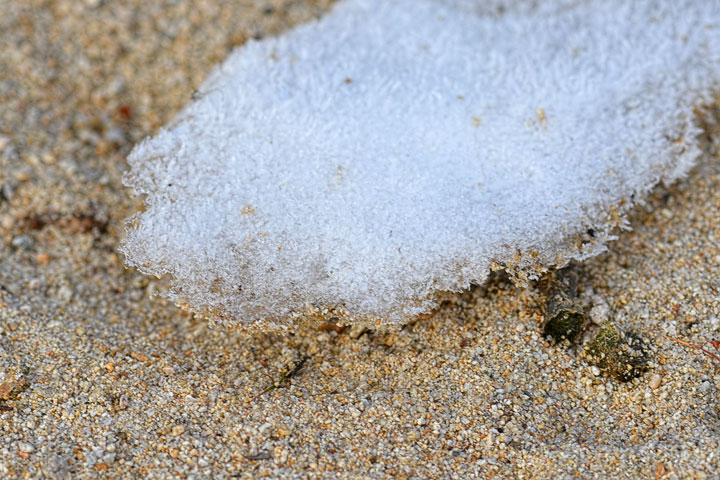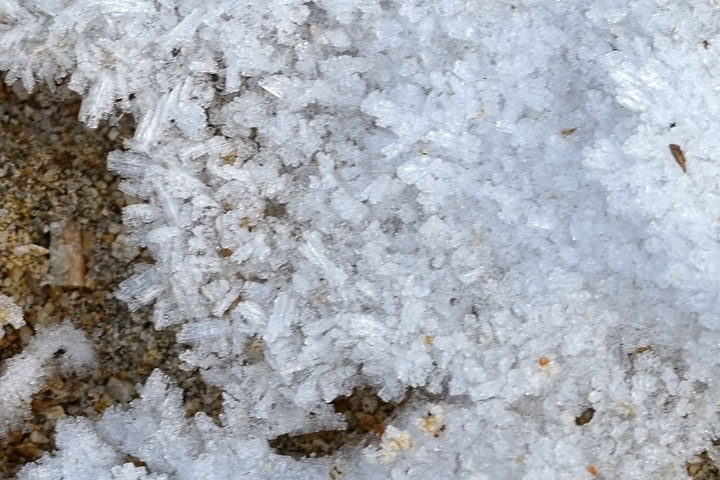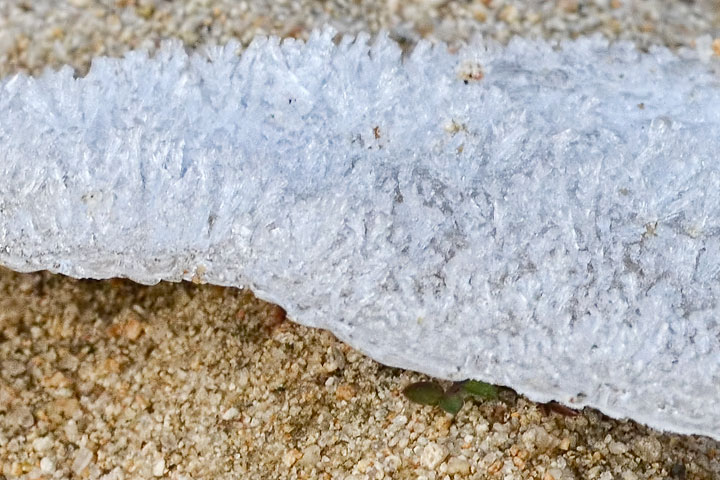Surface hoar is frost that forms on the surface of snow. Strikingly, this frost is not formed from water vapour deposited from the atmosphere, but from that which came from the snow, itself.
Uncharacteristic for this time of year, the snow in the valleys is found in patches. While surface hoar can form on any snow, the patches are ideal for exploring its behaviour.
Usually when one sees frost on a cold surface, the source of the water vapour that was deposited (or condensed) onto that surface came from the atmosphere. For example, if you see the outside of your car’s windscreen covered with frost, the vapour that condensed to form that frost came from the surrounding air. The frost on the windshield is not surface hoar (although some sloppy websites assert it to be so).
With surface hoar, there is another—almost always far more important—source of water vapour: the snow upon which the frost forms. Water vapour diffuses to the surface from within the snowpack. This behaviour has some interesting consequences for skiing and avalanches, but for the moment, the only concern is recognizing and understanding it. For this, the present patches of snow found on a beach, or a lawn, are ideal.
The first picture shows a patch of snow on a beach. There are a few striking features: the surface of the snow appears granular as if covered with frost—it is, as we will see. Yet, there is no frost on the surrounding sand. As the temperature of the surface of the snow and surface of the surrounding sand are virtually identical, if the water vapour had come from the atmosphere, frost would have formed equally on both surfaces. Another feature of the picture: the snow patch, oddly, seems to be elevated above the sand.

A closer examination of a snow patch reveals that it is indeed frost on the snow, although there is none on the adjacent sand.

The next picture, a side view of the snow patch, allows for an easier explanation. Although the sand and snow look different in the visible, they are almost identical in the portion of the spectrum that counts when the Sun is not up: the infrared. The sand and the snow both emit similar amounts of infrared radiation and both receive the same lesser amounts from the sky. So, the surface temperature of, say, the top millimeter of the exposed sand and snow cool similarly; if the water vapour came from the atmosphere, both would bear frost. However, as the base of the snow remains warmer, the vapour pressure there will be greater, and this results in a flow of vapour up through the snow pack. The warmer bottom of the pack evaporates to supply the vapour that then condenses on the colder top. The result is the ablation of the snow pack at the bottom and the formation of frost on the top.
The frost formed this way is called surface hoar and, when it is seen, the snow just below it has been weakened. It is easy to see on these isolated patches of snow, but on a larger scale, it clearly will have consequences for skiing and avalanches.

When the temperature gradient is strong (> 1 degree / 10cm) water vapour moves rapidly from warm grain surfaces to colder surfaces. Because the snowpack usually is warm (at or near 0 degrees C) at the ground and colder at the surface, ice sublimates from lower, warmer grains and is deposited onto colder grains higher up in the snowpack. These colder grains first develop sharp corners, then stepped facets.